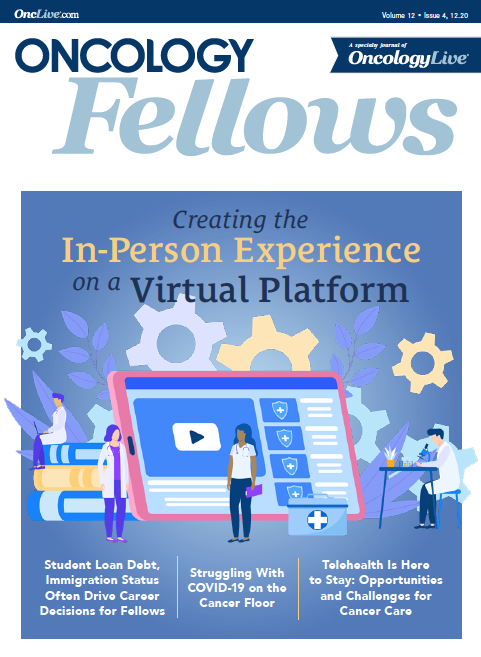Publication
Article
Oncology Fellows
Struggling With COVID-19 on the Cancer Floor
Author(s):
For the population of hospitalized patients with cancer, many of whom who have not contracted the disease, COVID-19 has real, immediate consequences; the pandemic has radically altered their end-of-life care.
Iris Y. Sheng, MD

Driving through downtown Cleveland on a recent September evening, there is hardly a mask in site. People are strolling down the street, laughing with friends, eating and drinking without a care in the world. For many, the coronavirus disease 2019 (COVID-19) pandemic is something they hear about or read in the newspaper, but it doesn’t have any immediate impact on their circle of loved ones.
For the population of hospitalized patients with cancer, many of whom who have not contracted the disease, COVID-19 has real, immediate consequences. The pandemic has radically altered their end-of-life care.
While home has surpassed the hospital as the most common place of death in the United States for the first time since the early 20th century, 40% of people older than age 65 who die with cancer are admitted to the intensive care unit in the last 180 days of life.1 More than 47,000 people older than age 65 die with cancer in the hospital each year.2 A critical aspect of end-of-life care involves frank discussion of goals of care with patients and their loved ones, and allowing patients to die with their loved ones at their side. Under normal circumstances, Cleveland Clinic, like many other hospitals, welcomes visitors for these patients at any time.
During the pandemic, we have been forced to adjust our visitation polices to protect our patients, staff, and visitors, and prevent the spread of COVID-19. At first, all visitors were forbidden except in the case for patients undergoing emergency surgery or end-of-life care and those who required a caregiver for a disability. On the oncology services floor, we are allowing 1 designated visitor for the entirety of the hospitalization with limited exceptions for rotation. However, for most patients, their support system extends beyond 1 person, leaving both patients and families devastated.
As a third-year fellow, I felt prepared to start my last 1-month rotation on the bone marrow transplant service. I started with zeal and high spirits—entirely naïve to the reality that this rotation, under these circumstances, would be more emotionally exhausting than any of my prior rotations. Traditionally, care of hospitalized patients starts with rounds by a small army of medical professionals that includes nurse practitioners, nurses, a pharmacist, a social worker, and a staff attending physician. My first day started with a dial-in call from the conference room.
Other team members logged in from a distanced hospital workstation or unused offices. After 90 minutes of “rounding,” my staff and I would see patients on our own and message the nurse practitioners with recommendations after exiting each room. In the afternoon, the nurse practitioners would page me their updates and I would discuss the patients 1-on-1 with my staff physician.
Despite our efforts to maximize communication with one another and with patients and families, this fragmented approach to maximize safety naturally made our patients feel isolated and dehumanized during a time when intimacy is critical. Worst of all, end-of-life conversations and experiences for patients and families were more painful and unforgettable given the limitations on visitation and impersonality of virtual meetings.
RN was a 48-year-old woman with recurrent acute myeloid leukemia (AML) following bone marrow transplant who was admitted for neutropenic septic shock.
During her hospitalization, we found she had multiple infectious sources, including pyelonephritis, fulminant Clostrioides difficile colitis, and a gluteal abscess. Despite early intervention, RN arrested. Although we achieved return of spontaneous circulation, she remained gravely ill.
We requested her husband come in for an end-of-life discussion. He wanted her mother and her children to be present, but due to our visitation policy, he had to come alone. Ultimately, he decided to change her code status to “do not resuscitate.” We requested special permission for her mother and children to visit the hospital. We couldn’t get approval in time and RN died before seeing the rest of her family.
RH deferred all his medical decision-making to his wife. She was elderly and fearful of entering the health care system, so we had all conversations about goals of care over the phone. During these 7 days of lengthy conversations and tears, discussing the risks and benefits of his disposition, I never saw her face. These moments are when nonverbal cues and affirmations are the most important. I left these meetings feeling unsettled, wondering if she felt at peace with her decision.
Ultimately, she made the decision for him to return home on hospice so she could hold her husband’s hand when he passed away. They wouldn’t have had that final moment of tenderness had he returned to his subacute rehabilitation facility.
DS was a 66-year-woman with AML hospitalized for cord transplant. Although she and her sons anticipated a long hospital stay on admission, no one imagined that she would not only still be on the floor 50 days later, but that there would be talks about a second transplant for potential graft failure. Her 3 sons wanted to be by her side because they knew their mother struggled with depression, but only 1 designated son was allowed for the entire hospitalization. She would ask us daily if her other sons could come, knowing our response.
I spoke with one of her sons, who lived out of state, on the phone. Every day, he pleaded for me to let him come in place of his brother. He could tell his mother was becoming more depressed and was fearful she was losing hope. Ultimately, we obtained permission to allow her son to take his brother’s place for a week. The joy when they finally saw each other was indescribable.
We were elated when DS finally engrafted and we began planning her discharge. Unfortunately, she developed hypoxic respiratory failure that necessitated transfer to the ICU. That was the tipping point for DS and her family. We requested special permission for all 3 of her sons to come to bedside. When she saw all 3 of them, she cried and told me she knew she was dying.
Thirty days never felt so long. Each of these people reminds me of the price we pay for the ongoing pandemic. Nothing will break your heart more than watching another human suffering and crying in the face of death. Nothing will ease the pain of hearing their loved ones’ sob over the phone. Nothing I do will make any of it any better.
But I am holding onto hope. I am hoping and praying for the day that everyone wears masks outside and abides by social distancing. I am hoping that medical science discovers a treatment or a vaccine for COVID-19. I am hoping we can lift hospital visitation policies and provide patient-centered care at the end-of-life as we once did.
Iris Y. Sheng, MD, PGY-6, is a Hematology/Oncology Fellow at the Cleveland Clinic Taussig Cancer Center in Cleveland, OH.
References
- Cross SH, Warraich HJ. Changes in the place of death in the United States. N Engl J Med. 2019;381(24):2369–2370. doi:10.1056/NEJMc1911892
- Bekelman JE, Halpern SD, Blankart CR, et al. Comparison of site of death, health care utilization, and hospital expenditures for patients dying with cancer in 7 developed countries. JAMA. 2016;315(3):272–283. doi:10.1001/jama.2015.18603










